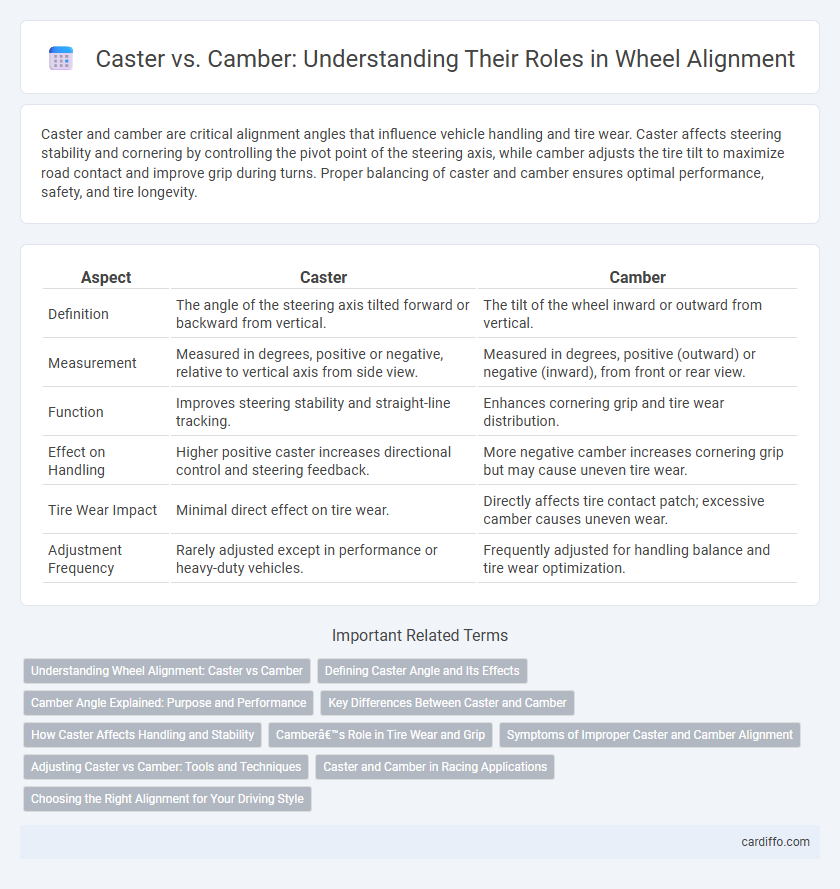Caster and camber are critical alignment angles that influence vehicle handling and tire wear. Caster affects steering stability and cornering by controlling the pivot point of the steering axis, while camber adjusts the tire tilt to maximize road contact and improve grip during turns. Proper balancing of caster and camber ensures optimal performance, safety, and tire longevity.
Table of Comparison
| Aspect | Caster | Camber |
|---|---|---|
| Definition | The angle of the steering axis tilted forward or backward from vertical. | The tilt of the wheel inward or outward from vertical. |
| Measurement | Measured in degrees, positive or negative, relative to vertical axis from side view. | Measured in degrees, positive (outward) or negative (inward), from front or rear view. |
| Function | Improves steering stability and straight-line tracking. | Enhances cornering grip and tire wear distribution. |
| Effect on Handling | Higher positive caster increases directional control and steering feedback. | More negative camber increases cornering grip but may cause uneven tire wear. |
| Tire Wear Impact | Minimal direct effect on tire wear. | Directly affects tire contact patch; excessive camber causes uneven wear. |
| Adjustment Frequency | Rarely adjusted except in performance or heavy-duty vehicles. | Frequently adjusted for handling balance and tire wear optimization. |
Understanding Wheel Alignment: Caster vs Camber
Caster refers to the angle of the steering axis when viewed from the side of the vehicle, directly impacting straight-line stability and steering effort. Camber is the vertical tilt of the wheel relative to the road surface, influencing tire wear and cornering performance. Proper alignment balances both caster and camber angles to optimize vehicle handling, safety, and tire longevity.
Defining Caster Angle and Its Effects
Caster angle refers to the tilt of the steering axis when viewed from the side of a vehicle, measured in degrees. Positive caster improves straight-line stability and steering feel by increasing tire contact patch during cornering, while negative caster can lead to unstable handling and less tire grip. Proper caster alignment enhances vehicle control, reduces tire wear, and provides better response in turns.
Camber Angle Explained: Purpose and Performance
Camber angle refers to the tilt of a vehicle's wheels relative to the vertical axis when viewed from the front or rear. Negative camber improves cornering grip by keeping the tire's contact patch flat during turns, enhancing performance and stability. Excessive camber can lead to uneven tire wear and reduced straight-line traction, requiring precise alignment for optimal handling.
Key Differences Between Caster and Camber
Caster refers to the angle of the steering axis when viewed from the side of the vehicle, influencing stability and steering effort, while camber denotes the tilt angle of the wheels relative to the vertical axis, impacting tire contact and wear. Positive caster improves straight-line stability by tilting the steering axis backward, whereas negative or positive camber affects handling responsiveness and cornering grip by altering the tire's contact patch. Proper alignment balances caster and camber settings to optimize vehicle control, tire longevity, and driving comfort.
How Caster Affects Handling and Stability
Caster angle profoundly influences vehicle handling and stability by affecting steering wheel returnability and directional control. A positive caster angle improves straight-line stability and enhances cornering by increasing the tire's contact patch during turns, resulting in better grip and feedback. Excessive caster, however, may increase steering effort, impacting maneuverability at low speeds.
Camber’s Role in Tire Wear and Grip
Camber plays a crucial role in tire wear and grip by affecting the contact patch between the tire and the road. Negative camber increases grip during cornering by maximizing the tire's contact with the pavement, while excessive negative camber accelerates uneven tire wear on the inner edges. Proper camber adjustment balances grip performance and tire longevity, optimizing overall vehicle handling and safety.
Symptoms of Improper Caster and Camber Alignment
Improper caster alignment can cause steering wheel instability, increased tire wear, and difficulty maintaining a straight path, often leading to a wandering vehicle. Incorrect camber angles result in uneven tire wear, such as excessive wear on the inner or outer edges, reducing tire lifespan and negatively impacting handling performance. Both misalignments can compromise vehicle safety by affecting traction and increasing the risk of accidents during cornering or braking.
Adjusting Caster vs Camber: Tools and Techniques
Adjusting caster requires precise use of shims or adjustable control arms to alter the steering axis tilt, improving high-speed stability and cornering response. Camber adjustments often involve camber bolts, eccentric bushings, or adjustable control arms to fine-tune tire contact with road surfaces, enhancing grip and tire wear. Proper alignment tools such as laser alignment systems or camber/caster gauges ensure accurate measurement and adjustment for optimal vehicle handling performance.
Caster and Camber in Racing Applications
Caster and camber angles play critical roles in racing vehicle alignment, directly affecting grip and handling performance on the track. Caster angle improves straight-line stability and enhances cornering precision by increasing steering feedback and self-centering force, which is crucial for high-speed maneuvering. Camber angle optimizes tire contact patch during aggressive cornering, with negative camber providing enhanced lateral grip but requiring careful adjustment to prevent uneven tire wear during racing conditions.
Choosing the Right Alignment for Your Driving Style
Choosing the right alignment between caster and camber significantly impacts vehicle handling and tire wear based on driving style. A higher positive caster angle enhances straight-line stability and steering return, ideal for high-speed driving, while adjustable camber angles improve cornering grip by optimizing tire contact with the road surface. Properly balancing caster and camber ensures precise steering response and maximizes traction tailored to aggressive or casual driving preferences.
Caster vs Camber Infographic

 cardiffo.com
cardiffo.com